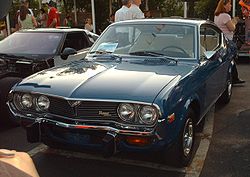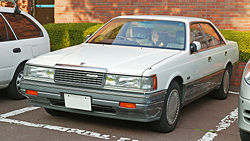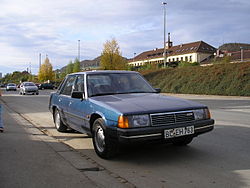- Mazda Luce
-
Mazda Luce Manufacturer Mazda Production 1966–1990 Successor Mazda Sentia Class luxury car Mazda used the Luce (pronounced lu-che) name on its largest sedans in Japan from 1969 until 1990. These vehicles were exported under a variety of names, including RX-4, 929, and Cosmo. The Luce nameplate was replaced by the Mazda Sentia name in 1991. The name "Luce" was taken from the Italian word for "light".
Contents
1965
Mark 1 Also called Luce 1500/1800/R130
Mazda 1500
Mazda 1800Production 1966–1972 (1500)
1968–1973 (1800)
1969–1972 (R130)
R130: <1,000 built [1]Body style 2-door coupé
4-door sedan
5-door station wagonLayout FR layout Engine 1.5 L UB I4 (1500)
1.8 L VB I4 (1800)
1.3 L 13A (R130) Wankel engineTransmission 4-speed manual Following an agreement signed with Bertone in April 1962, the 1965 Luce 1500 show car was designed by Giorgetto Giugiaro of Italy. It was low and sharp, looking more like a contemporary BMW Bavaria than any of its smaller Mazda brothers.
The production version, launched in August 1966, had a higher roofline but retained the BMW look. It was a front-engine, rear wheel drive 4-door sedan, and featured a square 1.5 L (1490 cc) 1500 SOHC engine, producing 78 hp (58,1 kW) at 5,500 rpm and 84.5 lb·ft (114.6 N·m). It sold poorly at ¥ 695,000 (US$1,930) and a stroked 1.8 L (1,796 cc) 1800 engine was added for 1968. This new model, the Luce 1800, produced 104 hp (74,5 kW) at 5,500 rpm and 112 lb ft at 2,500 rpm. An estate (station wagon) was also added. It was introduced two years before the Toyota Corona Mark II and the Nissan Laurel in Japan.
The Luce Mark I was sold in Australia under the names "Mazda 1500"[2] and "Mazda 1800".[3]
R130
A rotary-powered Luce appeared in 1969. The Luce R130 was produced from October 1969 to 1972. It used a 1.3 L 13A engine, which produced 126 hp (94 kW) and 127 ft·lbf (172 Nm). Quarter-mile (400 m) performance was 16.9 seconds. This model was a front wheel drive two door coupé with front disc brakes. This model, Mazda's only front-wheel drive rotary, is now a collector's item and very rare.
1800 (USA)
The Mazda brand entered the United States market in 1970 with just the small R100, but expanded to a full line in 1971. This included all three of the company's piston-powered models, the compact 1200, mid-size 616, and full-size 1800.[4]
The US-market 1800 produced 98 hp (73 kW) and 108 lb·ft (146 N·m) and cost US$2,280. Performance was sluggish, with a 0-60 mph time of 17.5 seconds and a 20.5 seconds and 65 mph (105 km/h) quarter mile. Unlike the rotary cars, the 1800 was a flop. Road & Track magazine said it was solid to the point of being overly heavy, with pleasant handling but poor performance. It was gone from the market for 1972.
Opposite to what happened in the U.S., in Europe the 1800 had a better performance with 104 hp (78 kW) at 5,500 rpm (SAE) and maximum torque of 109 lb·ft (148 N·m) at 3,000 rpm (SAE), for a 0-60 mph time of 13.4 seconds. The poor performance of this engine in USA was probably due to fact that in USA the petrol had an octane index of only 85 r.o.n. while in Europe the petrol at the time had an octane index of 95 r.o.n (up to 100 r.o.n. today). Also the manual transmission with four gears used in Europe contributed to a much better performance than the three-speed automatic transmission usually used in the US. The 1800 (fitted with a manual transmission) also sold in small numbers in Australia.
The number of Mazda 1800 automobiles imported into the U.S. are as follows.
- 1970 - 1,058 Sedan - 937 Estate
- 1971 - 1,020 Sedan - 1,639 Estate
- 1972 - 100 Sedan - 0 Estate
The 1800 saloon (model SVA - 4-door) was producedn from 1968 through 1973 where a reported 39,401 units were made. An 1800 estate version (model SVAV - station wagon) was added in 1970.
1972
Mark 2 
Also called Mazda 929
Mazda RX-4Production 1972 – 1977 Body style 2-door coupé
4-door sedan
5-door station wagonLayout FR layout Engine 1.2 L 12A Wankel
1.3 L 13B Wankel
1.8 L VC I4
2.0 L F/MA I4Transmission 4-speed manual
3-speed automaticThe 1972 rotary Luce was also known as the Mazda RX-4 in export markets. It was available as a coupé, sedan, and "custom" (station wagon). Two rotary engines were offered, the regular 12A and low-emission AP 13B.
Engines:
- 1973-1976 1.8 L (1,769 cc) 1800 I4, 2 barrel, 83 hp (61 kW)/101 ft·lbf (137 N·m)
- 1975-1976 2.0 L (1,970 cc) F/MA I4, 2 barrel, 103 hp (76 kW)/123 ft·lbf (167 N·m)
- 1972-1976 13B (1,308 cc), 127 hp (93 kW)/138 ft·lbf (188 N·m)
1977
Mark 3 
Also called Mazda Luce Legato
Mazda 929
Mazda RX-9Production 1977 – 1981 Body style 4-door hardtop
4-door sedan
5-door station wagonLayout FR layout Engine 1.2 L 12A rotary
1.3 L 13B rotary
1.8 L VC I4
2.0 L F/MA I4Transmission 4-speed manual
5-speed manual
3-speed automaticThe 1978 Luce Legato (introduced in October, 1977) was a large and luxurious sedan, still powered by Mazda's piston or rotary engines. It was also available as a four-door pillarless hardtop that looked like a huge, square coupé, and a wagon, which had more of a utilitarian role than the sedans.
Aside from the regular piston engine variants, the 12A or 13B rotary engines were on offer. The piston engined variants were exported as the Mazda 929. A rotary engine version was exported to "general issue" countries & sold as an RX-9. Most RX-9's were sold with the smaller 12A engine.
A facelift was given to the range in 1980, giving the car a more 'European' styled front. When the range was replaced in 1981, the wagon models continued, due to there being no wagon model of the new range developed.
Engines:
- 1977-1980 1.8 L (1,769 cc) I4, 2 barrel, 83 hp (61 kW)/101 ft·lbf (137 N·m)
- 1977-1980 2.0 L F/MA (1,970 cc) I4, 1 barrel, 90 hp (66 kW)
- 1977-1980 13B, 127 hp (93 kW)/138 ft·lbf (188 N·m)
- 1980-1980 2.2 L diesel, 66 hp (49 kW)/104 ft·lbf (142 N·m)
1981
Mark 4 Also called Mazda Cosmo
Mazda 929Production 1981 – 1986 Body style 2-door hardtop
4-door hardtop
4-door sedanLayout FR layout Engine 2.0 L F/MA I4
2.0 L FE I4
1.2 L 12A Wankel
1.3 L 13B WankelTransmission 5-speed manual
3-speed automaticFor 1981, Mazda brought back the Cosmo name for the HB platform Luce coupé. The sedan was also exported as the Mazda 929. The wagon was essentially the same as the last one from the A-pillar back. Production of the Cosmo continued after the Luce was replaced in 1986.
Engines:
- 1981-1986 2.0 L (1970 cc) MA I4, 1 barrel, 90 hp (66 kW)/118 ft·lbf (160 N·m)
- 1981-1986 2.0 L (1998 cc) FE I4, 2 barrel, 101 hp (74 kW)/115 ft·lbf (156 N·m)
- 1981-1986 2.0 L (1998 cc) FE I4, FI, 118 hp (87 kW)/126 ft·lbf (171 N·m)
1986
Mark 5 
Also called Mazda 929 Production 1986 – 1991 Body style
4-door hardtop
4-door sedanLayout FR layout Engine 2.0 L FE I4
2.2 L F2 I4
2.0 L JF V6
3.0 L JE V6
1.3 L 13B turbocharged WankelTransmission 4-speed automatic
5-speed manualThe 1986 Luce was large and luxurious on the HC platform, now with the 13B turbo engine as one of many engine options. It was still exported as the 929, and differed from the (continued) Cosmo. In the 1990s Mazda sold the body stampings to Kia where it was reproduced until the early first decade of the 21st century in piston form and sold in Korea only.
1991 was the last year of the Luce nameplate. The Eunos Cosmo was already on sale (JC), and the HD platform spawned the Mazda Sentia (now exported as the 929), and the Efini MS-9, making 1991 the last year for a 4-door rotary powered sedan prior to the RX-8.
Engines:
- 1986-1991 2.0 L (1,998 cc) FE I4, FI, 116 hp (85 kW)/121 ft·lbf (164 N·m)
- 1986-1991 2.2 L (2,184 cc) F2 I4, 1 barrel, 115 hp (85 kW)/129 ft·lbf (175 N·m)
- 1986-1991 2.2 L (2,184 cc) F2 I4, FI, 127 hp (93 kW)/141 ft·lbf (192 N·m)
- 2.0 L JF V6
- 2.0 L JFT V6 FI, 150 hp (112 kW)
- 1986-1991 3.0 L (2,954 cc) JE V6, FI, 165 hp (121 kW)/182 ft·lbf (247 N·m)
- 13B turbo
References
External links
- [1] Crazy on this car: Hemmings Sports & Exotic Car, 1967 Luce 1500
Mazda Wankel rotary timeline Type 1960s 1970s 1980s 1990s 2000s 2010s 5 6 7 8 9 0 1 2 3 4 5 6 7 8 9 0 1 2 3 4 5 6 7 8 9 0 1 2 3 4 5 6 7 8 9 0 1 2 3 4 5 6 7 8 9 0 1 Compact Familia/R100 R100 Mid-size Capella/RX-2 RX-2 Luce/RX-4 R130 RX-4 Legato HB HC Full-size Roadpacer RP GT Cosmo/RX-5 L10A L10B CD HB JC Sports Savanna/RX-3/RX-7/RX-8 RX-3 SA FB FC FD SE Pickup Proceed/REPU REPU « previous — Mazda road car timeline, 1990s–present Type 1990s 2000s 2010s 0 1 2 3 4 5 6 7 8 9 0 1 2 3 4 5 6 7 8 9 0 1 Kei car Carol Carol Carol Carol Carol AZ-Wagon AZ-Wagon AZ-Wagon AZ-Wagon AZ-Offroad Spiano Scrum Scrum/Scrum Wagon Scrum/Scrum Wagon Subcompact Revue/121 Demio/121 Demio/Mazda2 Demio/Mazda2 Verisa Compact Familia/323/Protegé Familia/323/Protegé Familia/323/Protegé Axela/Mazda3 Axela/Mazda3 Familia Van Familia Van Familia Van Mid-size Capella/626 Capella Capella/626 Atenza/Mazda6 Atenza/Mazda6 Cronos/626/Xedos 6/Eunos 500 Eunos 800/Xedos 9/Millenia Mazda6 (N.America) Full-size Sentia/929/Efini MS-8 Sentia Sports car AZ-1 MX-3 Precidia Roadster/MX-5/Miata Roadster/MX-5/Miata Roadster/MX-5 MX-6/Mystère MX-6/Mystère/Efini MS-6 RX-7 Efini RX-7/RX-7 RX-8 Cosmo Minivan Premacy Premacy/Mazda5 Premacy/
Mazda5Bongo Friendee Biante Efini MPV/MPV MPV MPV/Mazda8 Crossover CX-7 CX-9 SUV Navajo Tribute Tribute Pickup B-Series B-Series B-Series BT-50 BT-50 Van Bongo Bongo Categories:- Mazda vehicles
- Rear wheel drive vehicles
- Luxury vehicles
- Vehicles with Wankel engines
- Vehicles introduced in 1966
Wikimedia Foundation. 2010.






